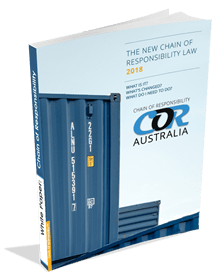Heavy Vehicle Report 2014
SOME OF THE NTC RECOMMENDATIONS
This report summarises the preliminary analysis the NTC provided as part of the targeted consultation process and feedback received from governments and industry through the targeted and public consultation processes. The recommendations in this report are based on this feedback and generally propose targeted, incremental improvements to the existing HVNL penalties framework. The recommendations aim to improve internal consistency across HVNL penalties and to enable more offences to be dealt with via infringement notices.
Term of reference 1: principles governing the use of monetary penalties
The Queensland Department of Transport and Main Roads proposed using a penalties matrix to ensure penalties are set accurately (based on risk, consequences, severity and likely offence frequency). The chain of responsibility (CoR) review aims to identify how to make the HVNL CoR regime more effective, appropriate and fair and may result in recommendations proposing changes to the HVNL penalties framework. The penalties matrix should be developed alongside, or as part of, any CoR amendment package.
Recommendation 1: that the NTC work with governments and industry to develop a penalties matrix to ensure penalties are set accurately. This process should occur alongside, or as part of, any chain of responsibility amendment package.
Term of reference 2: relativities between laws
Transport for New South Wales proposed increasing the maximum court-imposable and infringement penalties under section 529. Increasing the maximum court-imposable penalty will improve internal consistency across maximum penalties in the HVNL and will improve relativity with the equivalent light vehicle penalties in New South Wales.
Recommendation 2: that the maximum penalty for using or permitting use of a heavy vehicle in contravention of a heavy vehicle defect notice in section 529 be increased from $3 000 to $6 000. This will result in a $600 infringement penalty based on the 10 per cent infringement value.
Term of reference 3: relativities within the law
Governments proposed increasing eight maximum court-imposable penalties and reducing one maximum court-imposable penalty to improve internal consistency across maximum penalties in the HVNL.
The NTC recommended that the penalty for driving while impaired by fatigue under section 228 be increased from $6 000 to $15 000 to align with a critical work and rest hours offence, but there was not consensus among TISOC members.
Recommendation 3: that the penalty for making a demand that may result in a driver exceeding the speed limit in section 213 be increased from $6 000 to $10 000 to align with the penalty for making a demand that may result in a driver driving while fatigued etc. in section 237(1).
Recommendation 4: that the penalty for failing to ensure a driver’s schedule will not cause driver to drive while fatigued etc. in section 233(1) be increased from $6 000 to $10 000 to align with the penalty for failing to ensure a driver’s schedule will not cause driver to exceed speed limit in section 207(1).
Recommendation 5: that the penalty for causing a driver to drive if particular requirements not complied with in section 208(1) be increased from $4 000 to $6 000 to align with the penalty for causing a driver to drive if particular requirements not complied with in section 234(1).
Recommendation 6: that the penalty for failing to record information required to be recorded immediately after starting work in section 297 be increased from $3 000 to $6 000 to align with the penalty for failing to make supplementary records in particular circumstances in section 305(1).
Recommendation 7: that the penalty for a driver failing to notify the record keeper if electronic work diary filled up etc. in section 309(2) be reduced from $6 000 to $3 000 to align with penalties for a driver failing to notify the Regulator if written work diary filled up etc. in section 306 and for a



